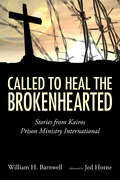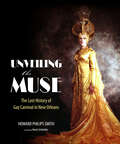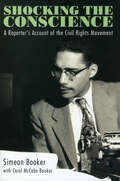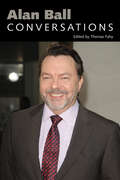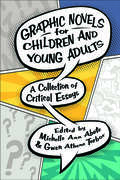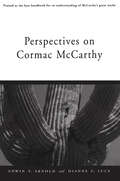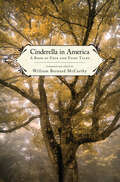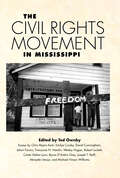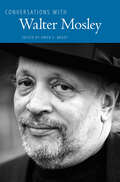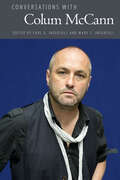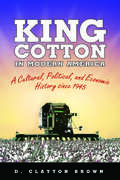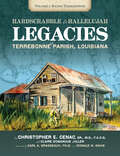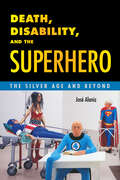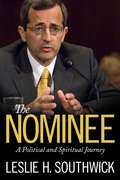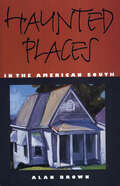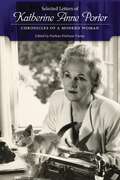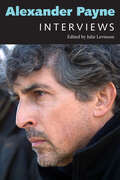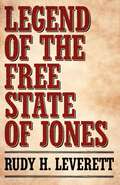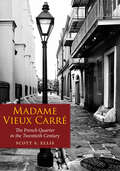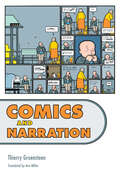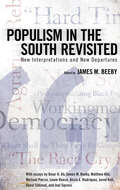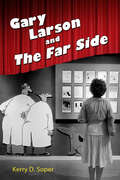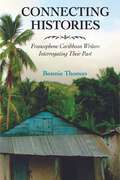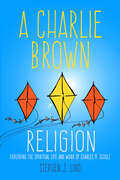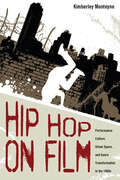- Table View
- List View
Called to Heal the Brokenhearted: Stories from Kairos Prison Ministry International
by William H. BarnwellIn this stirring book, William H. Barnwell tells the stories of prison inmates and the Kairos Prison Ministry volunteers who work with them. Set mostly at the huge Louisiana State Penitentiary at Angola, Barnwell's narrative illustrates how offenders who have done the worst can and do change, becoming model inmates and, if released, productive citizens. The stories also reveal how Kairos volunteers have found healing for broken hearts.Given that the United States incarcerates more people per capita than any country in the world, reformers are seeking radically new ways to reduce our prison populations. Kairos volunteers and inmates alike have much to contribute to the ongoing reform discussions. Now serving 300 state and federal prisons, 30,000 Kairos volunteers work with 20,000 inmates each year. They take part in long weekend retreats with the inmates and follow up with regular prison visits. Since its beginning in 1976, Kairos has served over 250,000 inmates. Broad-based, nondenominational, and nonjudgmental Christian, Kairos seeks to carry out its slogan--"listen, listen, love, love"--among inmates who have had few to listen to them, and fewer still to love them.In Called to Heal the Brokenhearted are stories of undeniable redemption. They point the way to personal transformation for the inmates and the volunteers. One Kairos inmate speaks of the change this way: he makes guitars out of the good wood "hidden beneath the surface" of throwaway pianos. "I find my work incredibly fulfilling," he says. "I see myself in every piano, discarded by society but redeemed and put to use in a new way."
Unveiling the Muse: The Lost History of Gay Carnival in New Orleans
by Howard Philips SmithTraditional Carnival has been well documented with a vast array of books published on the subject. However, few of them, if any, mention gay Carnival krewes or the role of gay Carnival within the larger context of the season. Howard Philips Smith corrects this oversight with a beautiful, vibrant, and exciting account of gay Carnival.Gay krewes were first formed in the late 1950s, growing out of costume parties held by members of the gay community. Their tableau balls were often held in clandestine locations to avoid harassment. Even by the new millennium, gay Carnival remained a hidden and almost lost history. Much of the history and the krewes themselves were devastated by the AIDS crisis. Whether facing police raids in the 1960s or AIDS in the 1980s, the Carnival krewes always came back each season. A culmination of two decades of research, Unveiling the Muse positions this incredible story within its proper place as an amazing and important facet of traditional Carnival.Based on years of detailed interviews, each of the major gay krewes is represented by an in-depth historical sketch, outlining the founders, moments of brilliance on stage, and a list of all the balls, themes, and royalty. Of critical importance to this history are the colorful ephemera associated with the gay tableau balls. Reproductions of never-before-published brilliantly designed invitations, large-scale commemorative posters, admit cards, and programs add dimension and life to this history. Sketches of elaborate stage sets and costumes as well as photographs of ball costumes and rare memorabilia further enhance descriptions of these tableau balls.
Shocking the Conscience: A Reporter's Account of the Civil Rights Movement
by Simeon BookerWithin a few years of its first issue in 1951, Jet, a pocket-sized magazine, became the “bible” for news of the civil rights movement. It was said, only half-jokingly, “If it wasn’t in Jet, it didn't happen.” Writing for the magazine and its glossy, big sister Ebony, for fifty-three years, longer than any other journalist, Washington bureau chief Simeon Booker was on the front lines of virtually every major event of the revolution that transformed America. Rather than tracking the freedom struggle from the usually cited ignition points, Shocking the Conscience begins with a massive voting rights rally in the Mississippi Delta town of Mound Bayou in 1955. It’s the first rally since the Supreme Court’s Brown decision struck fear in the hearts of segregationists across the former Confederacy. It was also Booker’s first assignment in the Deep South, and before the next run of the weekly magazine, the killings would begin. Booker vowed that lynchings would no longer be ignored beyond the black press. Jet was reaching into households across America, and he was determined to cover the next murder like none before. He had only a few weeks to wait. A small item on the AP wire reported that a Chicago boy vacationing in Mississippi was missing. Booker was on it, and stayed on it, through one of the most infamous murder trials in US history. His coverage of Emmett Till’s death lit a fire that would galvanize the movement, while a succession of US presidents wished it would go away. This is the story of the century that changed everything about journalism, politics, and more in America, as only Simeon Booker, the dean of the black press, could tell it.
Alan Ball: Conversations (Television Conversations Series)
by Thomas FahyAlan Ball: Conversations features interviews that span Alan Ball's entire career and include detailed observations and insights into his Academy Award-winning film American Beauty and Emmy Award-winning television shows Six Feet Under and True Blood. Ball began his career as a playwright in New York, and his work soon caught the attention of Hollywood television producers. After writing for the sitcoms Grace Under Fire and Cybill, Ball turned his attention to the screenplay that would become American Beauty. The critical success of this film opened up exciting possibilities for him in the realm of television. He created the critically acclaimed show Six Feet Under, and after the series finale, he decided to explore the issue of American bigotry toward the Middle East in his 2007 play All That I Will Ever Be and the film Towelhead, which he adapted and directed in the same year. Ball returned to television once again with the series True Blood—an adaptation of the humorous, entertaining, and erotic world of Charlaine Harris’s vampire novels. In 2012 Ball announced that he would step down as executive producer of True Blood, in part, to produce both a new television series and his screenplay, What’s the Matter with Margie?
Graphic Novels for Children and Young Adults: A Collection of Critical Essays (Children's Literature Association Series)
by Michelle Ann Abate & Gwen Athene TarboxWith contributions by Eti Berland, Rebecca A. Brown, Christiane Buuck, Joanna C. Davis-McElligatt, Rachel Dean-Ruzicka, Karly Marie Grice, Mary Beth Hines, Krystal Howard, Aaron Kashtan, Michael L. Kersulov, Catherine Kyle, David E. Low, Anuja Madan, Meghann Meeusen, Rachel L. Rickard Rebellino, Rebecca Rupert, Cathy Ryan, Joe Sutliff Sanders, Joseph Michael Sommers, Marni Stanley, Gwen Athene Tarbox, Sarah Thaller, Annette Wannamaker, and Lance WeldyOne of the most significant transformations in literature for children and young adults during the last twenty years has been the resurgence of comics. Educators and librarians extol the benefits of comics reading, and increasingly, children's and YA comics and comics hybrids have won major prizes, including the Printz Award and the National Book Award. Despite the popularity and influence of children's and YA graphic novels, the genre has not received adequate scholarly attention.Graphic Novels for Children and Young Adults is the first book to offer a critical examination of children's and YA comics. The anthology is divided into five sections, structure and narration; transmedia; pedagogy; gender and sexuality; and identity, that reflect crucial issues and recurring topics in comics scholarship during the twenty-first century. The contributors are likewise drawn from a diverse array of disciplines--English, education, library science, and fine arts. Collectively, they analyze a variety of contemporary comics, including such highly popular series as Diary of a Wimpy Kid and Lumberjanes; Eisner award-winning graphic novels by Gene Luen Yang, Nate Powell, Mariko Tamaki, and Jillian Tamaki; as well as volumes frequently challenged for use in secondary classrooms, such as Raina Telgemeier's Drama and Sherman Alexie's The Absolutely True Diary of a Part-Time Indian.
Perspectives on Cormac McCarthy
by Edwin T. ArnoldOriginally published in 1993, this was the first volume of essays devoted to the works of Cormac McCarthy. Immediately it was recognized as a major contribution to studies of this acclaimed American author. American Literary Scholarship hailed it as “a model of its kind.” It has since established itself as an essential source for any McCarthy scholar, student, or serious reader. In 1993, McCarthy had recently published All the Pretty Horses (1992), the award-winning first volume of the “Border Trilogy.” The second volume, The Crossing, appeared in 1994, and the concluding novel, Cities of the Plain, in 1998. The completion of the trilogy, one of the most significant artistic achievements in recent American literature, calls for further consideration of McCarthy's career. This revised volume, therefore, contains in addition to the original essays an updated version of Gail Morrison's article on All the Pretty Horses, plus two original essays by the editors of The Crossing (Luce) and Cities of the Plain (Arnold). Except for McCarthy's drama, The Stonemason (1994), all the major publications are covered in this collection. Cormac McCarthy is now firmly established as one of the masters of American literature. His first four novels, his screenplay “The Gardener's Son,” and his drama The Stonemason are all set in the South. Starting with Blood Meridian (1985), he moved west to the border country of Texas and Old and New Mexico, to create masterpieces of the western genre. Few writers have so completely and successfully described such different locales, customs, and people. Yet McCarthy is no regionalist. His work centers on the essential themes of self-determination, faith, courage, and the quest for meaning in an often violent and tragic world. For his readers wishing to know McCarthy's works this collection is both an introduction and an overview.
Cinderella in America: A Book of Folk and Fairy Tales
by William Bernard MccarthyFor years, many folklorists have denied the possibility of a truly American folk or fairy tale. They have argued that the tales found in the United States are watered-down derivatives of European fare. With this gathering, William Bernard McCarthy compiles evidence strongly to the contrary. Cinderella in America: A Book of Folk and Fairy Tales represents these tales as they have been told in the United States from Revolutionary days until the present. To capture this richness, tales are grouped in chapters that represent regional and ethnic groups, including Iberian, French, German, British, Irish, other European, African American, and Native American. These tales are drawn from published collections, journals, and archives, and from fieldwork by McCarthy and his colleagues. Created along the nationalist model of the Brothers Grimm yet as diverse in its voices and themes as the nation it represents, Cinderella in America shows these tales truly merit the designation American.
The Civil Rights Movement in Mississippi (Chancellor Porter L. Fortune Symposium in Southern History Series)
by Ted OwnbyContributions by Chris Myers Asch, Emilye Crosby, David Cunningham, Jelani Favors, Françoise N. Hamlin, Wesley Hogan, Robert Luckett, Carter Dalton Lyon, Byron D'Andra Orey, Ted Ownby, Joseph T. Reiff, Akinyele Umoja, and Michael Vinson WilliamsBased on new research and combining multiple scholarly approaches, these twelve essays tell new stories about the civil rights movement in the state most resistant to change. Wesley Hogan, Françoise N. Hamlin, and Michael Vinson Williams raise questions about how civil rights organizing took place. Three pairs of essays address African Americans' and whites' stories on education, religion, and the issues of violence. Jelani Favors and Robert Luckett analyze civil rights issues on the campuses of Jackson State University and the University of Mississippi. Carter Dalton Lyon and Joseph T. Reiff study people who confronted the question of how their religion related to their possible involvement in civil rights activism. By studying the Ku Klux Klan and the Deacons for Defense in Mississippi, David Cunningham and Akinyele Umoja ask who chose to use violence or to raise its possibility.The final three chapters describe some of the consequences and continuing questions raised by the civil rights movement. Byron D'Andra Orey analyzes the degree to which voting rights translated into political power for African American legislators. Chris Myers Asch studies a Freedom School that started in recent years in the Mississippi Delta. Emilye Crosby details the conflicting memories of Claiborne County residents and the parts of the civil rights movement they recall or ignore.As a group, the essays introduce numerous new characters and conundrums into civil rights scholarship, advance efforts to study African Americans and whites as interactive agents in the complex stories, and encourage historians to pull civil rights scholarship closer toward the present.
Conversations with Walter Mosley (Literary Conversations Series)
by Owen E. BradyThe interviews in this collection cover Walter Mosley's career and reveal an overarching theme: a belief in the transformative power of reading and writing. Since the 1990 publication of his first novel, Devil in a Blue Dress, Mosley (b. 1952) has published over thirty books in a tremendous range of genres and modes: crime and detective fiction, science fiction, literary novels of ideas, character studies, political and social nonfiction, erotica, and memoir. Best known for his Easy Rawlins detective series and Socrates Fortlow series of crime novels, Mosley has created a body of work that as a whole chronicles and examines twentieth-century African American experience. Conversations with Walter Mosley covers the breadth of Mosley's career and reveals a craftsman and wryly witty conversationalist. Conscious of his forebears as well as literary techniques, he discusses favorites and influences including Camus, Shakespeare, and Dickens as well as writers in popular genres—especially speculative fiction and the hard-boiled noir detective tradition. He also discusses how his work modifies the crime tradition to engage it with black experience.
Conversations with Colum McCann (Literary Conversations Series)
by Earl G. Ingersoll and Mary C. IngersollConversations with Colum McCann brings together eighteen interviews with a world-renowned fiction writer. Ranging from his 1994 literary debut, Fishing the Sloe-Black River, to a previously unpublished interview conducted in 2016, these interviews represent the development as well as the continuation of McCann's interests. The number and length of the later conversations attest to his star-power. Let the Great World Spin earned him the National Book Award and promises to become a major motion picture. His most recent novel, TransAtlantic, has awed readers with its dynamic yoking of the 1845-46 visit of Frederick Douglass to Ireland, the 1919 first nonstop transatlantic flight of Alcock and Brown, and Senator George Mitchell's 1998 efforts to achieve a peace accord in Northern Ireland. An extensive interview by scholar Cécile Maudet is included here, as is an interview by John Cusatis, who wrote Understanding Colum McCann, the first extensive critical analysis of McCann's work. An author who actually enjoys talking about his work, McCann (b. 1965) offers insights into his method of writing, what he hopes to achieve, as well as the challenge of writing each novel to go beyond his accomplishments in the novel before. Readers will note how many of his responses include stories in which he himself is the object of the humor and how often his remarks reveal insights into his character as a man who sees the grittiness of the urban landscape but never loses faith in the strength of ordinary people and their capacity to prevail.
King Cotton in Modern America: A Cultural, Political, and Economic History since 1945
by D. Clayton BrownKing Cotton in Modern America places the once kingly crop in historical perspective, showing how "cotton culture" was actually part of the larger culture of the United States despite many regarding its cultivation and sources as hopelessly backward. Leaders in the industry, acting through the National Cotton Council, organized the various and often conflicting segments to make the commodity a viable part of the greater American economy. The industry faced new challenges, particularly the rise of foreign competition in production and the increase of man-made fibers in the consumer market.Modernization and efficiency became key elements for cotton planters. The expansion of cotton- growing areas into the Far West after 1945 enabled American growers to compete in the world market. Internal dissension developed between the traditional cotton growing regions in the South and the new areas in the West, particularly over the USDA cotton allotment program. Mechanization had profound social and economic impacts. Through music and literature, and with special emphasis placed on the meaning of cotton to African Americans in the lore of Memphis's Beale Street, blues music, and African American migration off the land, author D. Clayton Brown carries cotton's story to the present.
Hard Scrabble to Hallelujah, Volume 1: Legacies of Terrebonne Parish, Louisiana (America's Third Coast Series)
by Christopher Everette Cenac Sr.Winner of a 2017 Louisiana Endowment for the Humanities Book of the Year AwardThis book represents the first time that the known history and a significant amount of new information has been compiled into a single written record about one of the most important eras in the south-central coastal bayou parish of Terrebonne. The book makes clear the unique geographical, topographical, and sociological conditions that beckoned the first settlers who developed the large estates that became sugar plantations. This first of four planned volumes chronicles details about founders and their estates along Bayou Terrebonne from its headwaters in the northern civil parish to its most southerly reaches near the Gulf of Mexico. Those and other parish plantations along important waterways contributed significantly to the dominance of King Sugar in Louisiana. The rich soils and opportunities of the area became the overriding reason many well-heeled Anglo-Americans moved there to join Francophone locals in cultivating the crop. From that nineteenth century period up to the twentieth century’s side effects of World Wars I and II, Hard Scrabble to Hallelujah, Volume I: Bayou Terrebonne describes important yet widely unrecognized geography and history. Today, cultural and physical legacies such as ex-slave-founded communities and place names endure from the time that the planter society was the driving economic force of this fascinating region.
Death, Disability, and the Superhero: The Silver Age and Beyond
by José AlanizThe Thing. Daredevil. Captain Marvel. The Human Fly. Drawing on DC and Marvel comics from the 1950s to the 1990s and marshaling insights from three burgeoning fields of inquiry in the humanities--disability studies, death and dying studies, and comics studies--José Alaniz seeks to redefine the contemporary understanding of the superhero. Beginning in the Silver Age, the genre increasingly challenged and complicated its hypermasculine, quasi-eugenicist biases through such disabled figures as Ben Grimm/The Thing, Matt Murdock/Daredevil, and the Doom Patrol.Alaniz traces how the superhero became increasingly vulnerable, ill, and mortal in this era. He then proceeds to a reinterpretation of characters and series--some familiar (Superman), some obscure (She-Thing). These genre changes reflected a wider awareness of related body issues in the postwar United States as represented by hospice, death with dignity, and disability rights movements. The persistent highlighting of the body's "imperfection" comes to forge a predominant aspect of the superheroic self. Such moves, originally part of the Silver Age strategy to stimulate sympathy, enhance psychological depth, and raise the dramatic stakes, developed further in such later series as The Human Fly, Strikeforce: Morituri, and the landmark graphic novel The Death of Captain Marvel, all examined in this volume. Death and disability, presumed routinely absent or denied in the superhero genre, emerge to form a core theme and defining function of the Silver Age and beyond.
The Nominee: A Political and Spiritual Journey (Willie Morris Books in Memoir and Biography)
by Leslie H. SouthwickPresident George W. Bush nominated Leslie H. Southwick in 2007 to the federal appeals court, Fifth Circuit, based in New Orleans. Initially, Southwick seemed a consensus nominee. Just days before his hearing, though, a progressive advocacy group distributed the results of research it had conducted on opinions of the state court on which he had served for twelve years. Two opinions Southwick had signed off on but not written became the center of the debate over the next five months. One dealt with a racial slur by a state worker, the other with a child custody battle between a father and a bisexual mother. Apparent bipartisan agreement for a quick confirmation turned into a long set of battles in the Judiciary Committee, on the floor of the Senate, and in the media.In early August, Senator Dianne Feinstein completely surprised her committee colleagues by supporting Southwick. Hers was the one Democratic vote needed to move the nomination to the full Senate. Then in late October, by a two-vote margin, he received the votes needed to end a filibuster. Confirmation followed.Southwick recounts the four years he spent at the Department of Justice, the twelve years on a state court, and his military service in Iraq while deployed with a Mississippi National Guard Brigade. During the nomination inferno Southwick maintained a diary of the many events, the conversations and emails, the joys and despairs, and quite often, the prayers and sense of peace his faith gave him--his memoir bears significant spiritual content. Throughout the struggle, Southwick learned that perspective and growth are important to all of us when making decisions, and he grew to accept his critics, regardless of outcome. In The Nominee there is no rancor, and instead the book expresses the understanding that the difficult road to success was the most helpful one for him, both as a man and as a judge.
Haunted Places in the American South
by Alan BrownBefore Alan Brown wrote Haunted Places in the American South, only the locals knew what was lurking in these locations. Slamming doors, eerie lights, and Confederate soldiers' ghosts kept some folks too scared to talk with outsiders. Above Peavey Melody Music in Meridian, Mississippi, children may be heard giggling and running down an abandoned hallway that turns icy cold. At the Jameson Inn in Crestview, Florida, an apparition appears on surveillance tapes after filling the lobby with sweet-smelling cigar smoke. Seldom told and rarely—if ever—printed stories such as these join tales from haunted inns, mansions, forests, ravines, and prisons to create Haunted Places in the American South. The book collects ghost stories from fifty-five historically haunted sites in Alabama, Arkansas, Florida, Georgia, Kentucky, Louisiana, Mississippi, North Carolina, South Carolina, Tennessee, Texas, and Virginia. Alan Brown gathered these stories from newspapers, magazines, museum directors, archaeologists, hotel managers, and many others who shared their disturbing experiences. Most of these stories have never appeared in book form, and some, such as the haunting of Peavey Melody Music, have never been published at all. Haunted Places in the American South differs from most other collections of southern ghost stories, for the featured sites include more than just haunted houses. Bridges, forts, governors' mansions, prisons, hotels, woods, theaters, cemeteries, and even a large rock are included as focal points for these tales. The book provides directions to the sites, notes, and a bibliography that will be useful to folklore scholars and to travelers seeking that cold and creepy brush with the supernatural.
Selected Letters of Katherine Anne Porter: Chronicles of a Modern Woman
by Darlene Harbour UnrueKatherine Anne Porter (1890–1980) produced a relatively small body of fiction, but she wrote thousands and thousands of letters. The present selection of 135 unexpurgated letters, written to seventy-four different persons, begins with a 1916 letter written from a tuberculosis sanatorium in Texas and ends with a 1979 letter dictated to an unnamed nursing-home attendant in Maryland. Different from any previous selection, this body of letters does not omit Porter's frank criticism of fellow writers and spans her entire life. Within that circumscription is the chronicle of Porter, a twentieth-century woman searching for love while she struggles to become the writer who she is sure she can be. Porter's letters vividly showcase the twentieth century as the writer observes it from her historical vantage points—tuberculosis sanatoria and the influenza pandemic of 1918; the leftist community in Greenwich Village in the 1920s; the Mexican cultural revolution of the 1920s and early 1930s; the expatriate community in Paris in the 1930s; the rise of Nazism in Europe between the World Wars; the Second World War and its concomitant suppression of civil liberties; Hollywood and the university circuit as a haven for financially strapped writers in the 1940s and 1950s; the Cold War and its competition for supremacy in space; the women's rights and the civil rights movements; and the evolution and demise of literary modernism.
Alexander Payne: Interviews (Conversations with Filmmakers Series)
by Julie LevinsonSince 1996, Alexander Payne (b. 1961) has made seven feature films and a short segment of an omnibus movie. Although his body of work is quantitatively small, it is qualitatively impressive. His movies have garnered numerous accolades and awards, including two Academy Awards for Best Adapted Screenplay. As more than one interviewer in this volume points out, he maintains an impressive and unbroken winning streak. Payne's stories of human strivings and follies, alongside his mastery of the craft of filmmaking, mark him as a contemporary auteur of uncommon accomplishment. In this first compilation of his interviews, Payne reveals himself as a captivating conversationalist as well. The discussions collected here range from 1996, shortly after the release of his first film, Citizen Ruth, to the 2013 debut of his film, Nebraska. He also mentions the long process of bringing to fruition his most recent film, Downsizing. Over his career, he muses on many subjects including his own creative processes, his commitment to telling character-centered stories, and his abiding admiration for movies and directors from across decades of film history. Critics describe Payne as one of the few contemporary filmmakers who consistently manages to buck the current trend toward bombastic blockbusters. Like the 1970s director-driven cinema that he cherishes, his films are small-scale character studies that manage to maintain a delicate balance between sharp satire and genuine poignancy.
Legend of the Free State of Jones
by Rudy H. LeverettA maverick, unionist district in the heart of the Old South? A notorious county that seceded from the Confederacy? This is how Jones County, Mississippi, is known in myth and legend.Since 1864 the legend has persisted. Differing versions give the name of this new nation as Republic of Jones, Jones County Confederacy, and Free State of Jones. Over the years this story has captured the imaginations of journalists, historians, essayists, novelists, short story writers, and Hollywood filmmakers, although serious scholars long ago questioned the accuracy of local history accounts about a secessionist county led by Newt Knight and a band of renegades.Legend of the Free State of Jones was the first authoritative explanation of just what did happen in Jones County in 1864 to give rise to the legend and now to a major motion picture starring Matthew McConaughey. This book surveys the facts, the records, and the history of the "Free State of Jones" and may provide the whole story.
Madame Vieux Carre: The French Quarter in the Twentieth Century
by Scott S. EllisCelebrated in media and myth, New Orleans's French Quarter (Vieux Carré) was the original settlement of what became the city of New Orleans. In Madame Vieux Carré, Scott S. Ellis presents the social and political history of this famous district as it evolved from 1900 through the beginning of the twenty-first century. From the immigrants of the 1910s, to the preservationists of the 1930s, to the nightclub workers and owners of the 1950s and the urban revivalists of the 1990s, Madame Vieux Carré examines the many different people who have called the Quarter home, who have defined its character, and who have fought to keep it from being overwhelmed by tourism's neon and kitsch. The old French village took on different roles—bastion of the French Creoles, Italian immigrant slum, honky-tonk enclave, literary incubator, working-class community, and tourist playground. The Quarter has been a place of refuge for various groups before they became mainstream Americans. Although the Vieux Carré has been marketed as a free-wheeling, boozy tourist concept, it exists on many levels for many groups, some with competing agendas. Madame Vieux Carré looks, with unromanticized frankness, at these groups, their intentions, and the future of the South's most historic and famous neighborhood. The author, a former Quarter resident, combines five years of research, personal experience, and unique interviews to weave an eminently readable history of one of America's favorite neighborhoods.
Comics and Narration
by Thierry GroensteenThis book is the follow-up to Thierry Groensteen's groundbreaking The System of Comics, in which the leading French-language comics theorist set out to investigate how the medium functions, introducing the principle of iconic solidarity, and showing the systems that underlie the articulation between panels at three levels: page layout, linear sequence, and nonsequential links woven through the comic book as a whole. He now develops that analysis further, using examples from a very wide range of comics, including the work of American artists such as Chris Ware and Robert Crumb. He tests out his theoretical framework by bringing it up against cases that challenge it, such as abstract comics, digital comics and shojo manga, and offers insightful reflections on these innovations. In addition, he includes lengthy chapters on three areas not covered in the first book. First, he explores the role of the narrator, both verbal and visual, and the particular issues that arise out of narration in autobiographical comics. Second, Groensteen tackles the question of rhythm in comics, and the skill demonstrated by virtuoso artists in intertwining different rhythms over and above the basic beat provided by the discontinuity of the panels. And third he resets the relationship of comics to contemporary art, conditioned by cultural history and aesthetic traditions but evolving recently as comics artists move onto avant-garde terrain.
Populism in the South Revisited: New Interpretations and New Departures
by James M. BeebyThe Populist Movement was the largest mass movement for political and economic change in the history of the American South until the Civil Rights Movement of the 1950s and 1960s. The Populist Movement in this book is defined as the Farmers' Alliance and the People's Party, as well as the Agricultural Wheel and Knights of Labor in the 1880s and 1890s. The Populists threatened the political hegemony of the white racist southern Democratic Party during populism's high point in the mid-1890s; and the populists threw the New South into a state of turmoil Populism in the South Revisited: New Interpretations and New Departures brings together nine of the best new works on the populist movement in the South that grapple with several larger themes—such as the nature of political insurgency, the relationship between African Americans and whites, electoral reform, new economic policies and producerism, and the relationship between rural and urban areas—in case studies that center on several states and at the local level. Each essay offers both new research and new interpretations into the causes, course, and consequences of the populist insurgency. One essay analyzes how notions of debt informed the Populist insurgency in North Carolina, the one state where the Populists achieved statewide power, while another analyzes the Populists' failed attempts in Grant Parish, Louisiana, to align with African Americans and Republicans to topple the incumbent Democrats. Other topics covered include populist grassroots organizing with African Americans to stop disfranchisement in North Carolina; the Knights of Labor and the relationship with populism in Georgia; organizing urban populism in Dallas, Texas; Tom Watson's relationship with Midwest Populism; the centrality of African Americans in populism, a comparative analysis of Populism across the Deep South, and how the rhetoric and ideology of populism impacted socialism and the Garvey movement in the early twentieth century. Together these studies offer new insights into the nature of southern populism and the legacy of the Peoples' Party in the South.
Gary Larson and The Far Side (Great Comics Artists Series)
by Kerry D. SoperKerry D. Soper reminds us of The Far Side's groundbreaking qualities and cultural significance in Gary Larson and "The Far Side." In the 1980s, Gary Larson (b. 1950) shook up a staid comics page by introducing a set of aesthetic devices, comedic tones, and philosophical frames that challenged and delighted many readers, even while upsetting and confusing others. His irreverent, single panels served as an alternative reality to the tame comedy of the family-friendly newspaper comics page, as well as the pervasive, button-down consumerism and conformity of the Reagan era.In this first full study of Larson's art, Soper follows the arc of the cartoonist's life and career, describing the aesthetic and comedic qualities of his work, probing the business side of his success, and exploring how The Far Side brand as a whole--with its iconic characters and accompanying set of comedic and philosophical frames--connected with its core readers. In effect, Larson reinvented his medium by creatively working within, pushing against, and often breaking past institutional, aesthetic, comedic, and philosophical parameters.Due to the comic's great success, it opened the door for additional alternative voices in comics and other popular mediums. With its intentionally awkward, minimalistic lines and its morbid humor, The Far Side expanded Americans' comedic palette and inspired up-and-coming cartoonists, comedians, and filmmakers. Soper re-creates the cultural climate and media landscape in which The Far Side first appeared and thrived, then assesses how it impacted worldviews and shaped the comedic sensibilities of a generation of cartoonists, comedy writers, and everyday fans.
Connecting Histories: Francophone Caribbean Writers Interrogating Their Past (Caribbean Studies Series)
by Bonnie ThomasThe Francophone Caribbean boasts a trove of literary gems. Distinguished by innovative, elegant writing and thought-provoking questions of history and identity, this exciting body of work demands scholarly attention. Its authors treat the traumatic legacies of shared and personal histories pervading Caribbean experience in striking ways, delineating a path towards reconciliation and healing. The creation of diverse personal narratives—encompassing autobiography, autofiction (heavily autobiographical fiction), travel writing, and reflective essay—remains characteristic of many Caribbean writers and offers poignant illustrations of the complex interchange between shared and personal pasts and how they affect individual lives. Through their historically informed autobiography, the authors in this study—Maryse Condé, Gisèle Pineau, Patrick Chamoiseau, Edwidge Danticat, and Dany Laferrière—offer compelling insights into confronting, coming to terms with, and reconciling their past. The employment of personal narratives as the vehicle to carry out this investigation points to a tension evident in these writers’ reflections, which constantly move between the collective and the personal. As an inescapably complex network, their past extends beyond the notion of a single, private life. These contemporary authors from Martinique, Guadeloupe, and Haiti intertwine their personal memories with reflections on the histories of their homelands and on the European and North American countries they adopt through choice or necessity. They reveal a multitude of deep connections that illuminate distinct Francophone Caribbean experiences.
A Charlie Brown Religion: Exploring the Spiritual Life and Work of Charles M. Schulz (Tom Inge Series on Comics Artists)
by Stephen J. LindCharles M. Schulz's Peanuts comic strip franchise, the most successful of all time, forever changed the industry. For more than half a century, the endearing, witty insights brought to life by Charlie Brown, Snoopy, Linus, and Lucy have caused newspaper readers and television viewers across the globe to laugh, sigh, gasp, and ponder. A Charlie Brown Religion explores one of the most provocative topics Schulz broached in his heartwarming work--religion.Based on new archival research and original interviews with Schulz's family, friends, and colleagues, author Stephen J. Lind offers a new spiritual biography of the life and work of the great comic strip artist. In his lifetime, aficionados and detractors both labeled Schulz as a fundamentalist Christian or as an atheist. Yet his deeply personal views on faith have eluded journalists and biographers for decades. Previously unpublished writings from Schulz will move fans as they begin to see the nuances of the humorist's own complex, intense journey toward understanding God and faith."There are three things that I've learned never to discuss with people," Linus says, "Religion, politics, and the Great Pumpkin." Yet with the support of religious communities, Schulz bravely defied convention and dared to express spiritual thought in the "funny pages," a secular, mainstream entertainment medium. This insightful, thorough study of the 17,897 Peanuts newspaper strips, seventy-five animated titles, and global merchandising empire will delight and intrigue as Schulz considers what it means to believe, what it means to doubt, and what it means to share faith with the world.
Hip Hop on Film: Performance Culture, Urban Space, and Genre Transformation in the 1980s
by Kimberley MonteyneEarly hip hop film musicals have either been expunged from cinema history or excoriated in brief passages by critics and other writers. Hip Hop on Film reclaims and reexamines productions such as Breakin' (1984), Beat Street (1984), and Krush Groove (1985) in order to illuminate Hollywood's fascinating efforts to incorporate this nascent urban culture into conventional narrative forms. Such films presented musical conventions against the backdrop of graffiti-splattered trains and abandoned tenements in urban communities of color, setting the stage for radical social and political transformations. Hip hop musicals are also part of the broader history of teen cinema, and films such as Charlie Ahearn's Wild Style (1983) are here examined alongside other contemporary youth-oriented productions. As suburban teen films banished parents and children to the margins of narrative action, hip hop musicals, by contrast, presented inclusive and unconventional filial groupings that included all members of the neighborhood. These alternative social configurations directly referenced specific urban social problems, which affected the stability of inner-city families following diminished governmental assistance in communities of color during the 1980s. Breakdancing, a central element of hip hop musicals, is also reconsidered. It gained widespread acclaim at the same time that these films entered the theaters, but the nation's newly discovered dance form was embattled—caught between a multitude of institutional entities such as the ballet academy, advertising culture, and dance publications that vied to control its meaning, particularly in relation to delineations of gender. As street-trained breakers were enticed to join the world of professional ballet, this newly forged relationship was recast by dance promoters as a way to invigorate and “remasculinize” European dance, while young women simultaneously critiqued conventional masculinities through an appropriation of breakdance. These multiple and volatile histories influenced the first wave of hip hop films, and even structured the sleeper hit Flashdance (1983). This forgotten, ignored, and maligned cinema is not only an important aspect of hip hop history, but is also central to the histories of teen film, the postclassical musical, and even institutional dance. Kimberley Monteyne places these films within the wider context of their cultural antecedents and reconsiders the genre's influence.
